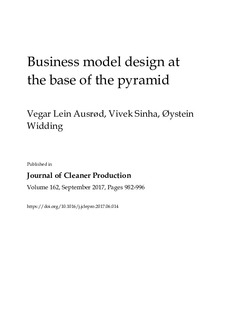| dc.contributor.author | Ausrød, Vegar Lein | |
| dc.contributor.author | Sinha, Vivek | |
| dc.contributor.author | Widding, Lars Øystein | |
| dc.date.accessioned | 2018-04-10T11:28:15Z | |
| dc.date.available | 2018-04-10T11:28:15Z | |
| dc.date.created | 2017-06-07T09:56:32Z | |
| dc.date.issued | 2017 | |
| dc.identifier.citation | Journal of Cleaner Production. 2017, 162 982-996. | nb_NO |
| dc.identifier.issn | 0959-6526 | |
| dc.identifier.uri | http://hdl.handle.net/11250/2493422 | |
| dc.description.abstract | The extant literature on Base of the Pyramid (BoP) business models reveals the following dilemma: Business models should both adapt to and shape the context in which they are deployed. This article focuses on how new ventures can design a business model bottom up while simultaneously adapting to and shaping the context in which the venture is operating. Through a single case study of a globally leading mini-utility firm in the rural electricity sector at the BoP, this article makes three contributions. First, it contributes to the literature on business model design by showing that specifically designed interim business models facilitate adaptation to and the shaping of the context. Second, the article refines the native capability construct, splitting it into native “pull” and “push” capabilities. This brings nuance to much of the BoP literature that suggests ventures yield to local context. Third, the article links the business model design and native pull/push capability to potential and realized absorptive capacity. Accordingly, hands-on strategies for developing potential and realized absorptive capacity are suggested. | nb_NO |
| dc.language.iso | eng | nb_NO |
| dc.publisher | Elsevier | nb_NO |
| dc.rights | Attribution-NonCommercial-NoDerivatives 4.0 Internasjonal | * |
| dc.rights.uri | http://creativecommons.org/licenses/by-nc-nd/4.0/deed.no | * |
| dc.title | Business model design at the base of the pyramid | nb_NO |
| dc.type | Journal article | nb_NO |
| dc.type | Peer reviewed | nb_NO |
| dc.description.version | acceptedVersion | nb_NO |
| dc.source.pagenumber | 982-996 | nb_NO |
| dc.source.volume | 162 | nb_NO |
| dc.source.journal | Journal of Cleaner Production | nb_NO |
| dc.identifier.doi | 10.1016/j.jclepro.2017.06.014 | |
| dc.identifier.cristin | 1474412 | |
| dc.relation.project | Norges forskningsråd: 205439 | nb_NO |
| dc.relation.project | Norges forskningsråd: 209697 | nb_NO |
| dc.description.localcode | © 2017. This is the authors’ accepted and refereed manuscript to the article. Locked until 6.6.2019 due to copyright restrictions. This manuscript version is made available under the CC-BY-NC-ND 4.0 license http://creativecommons.org/licenses/by-nc-nd/4.0/ | nb_NO |
| cristin.unitcode | 194,60,25,0 | |
| cristin.unitname | Institutt for industriell økonomi og teknologiledelse | |
| cristin.ispublished | true | |
| cristin.fulltext | postprint | |
| cristin.qualitycode | 2 | |

